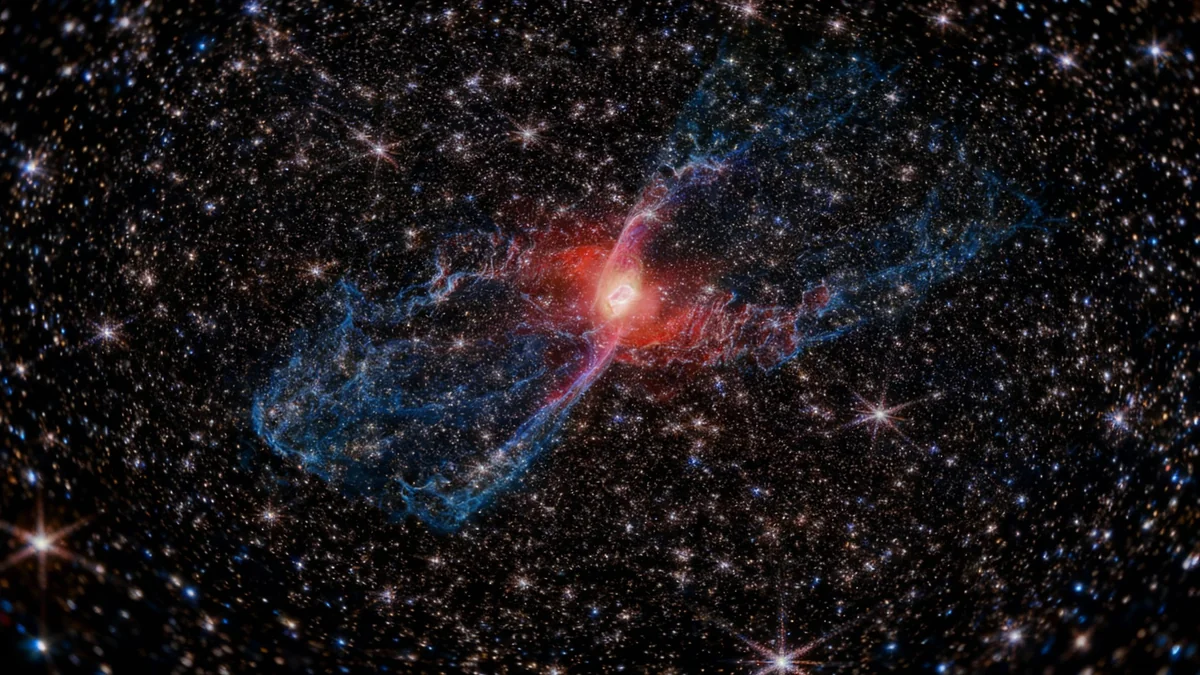For the first time, astronomers have captured a direct radio image of two supermassive black holes orbiting each other, providing visual confirmation of a long-standing astronomical theory. The pair is located at the center of a quasar known as OJ287, approximately 5 billion light-years from Earth in the constellation Cancer.
This achievement, the result of decades of observation and advanced telescope technology, offers the clearest evidence to date that binary supermassive black holes exist and interact in a predictable cosmic dance. The findings were published on October 9 in The Astrophysical Journal.
Key Takeaways
- Astronomers have successfully imaged two supermassive black holes orbiting one another for the first time.
- The binary system is located in the quasar OJ287, which is 5 billion light-years away.
- The image confirms a theory first proposed in the 1980s based on the quasar's regular 12-year brightness cycle.
- The high-resolution image was created by combining data from Earth-based radio telescopes and the RadioAstron space satellite.
A Century of Observation Leads to Confirmation
The quasar OJ287 is not a new discovery. It has appeared on astronomical photographic plates since the late 1800s, long before the concepts of black holes or quasars were understood. For decades, it was just another point of light in the vastness of space.
However, the object began to attract significant scientific attention in 1982. Finnish astronomer Aimo Sillanpää noted that OJ287's brightness fluctuated in a consistent 12-year cycle. This regularity led him to propose that the quasar might host not one, but two supermassive black holes orbiting each other.
What is a Quasar?
Quasars are extremely luminous objects found at the centers of some galaxies. Their brightness comes from an accretion disk—a swirling mass of gas, dust, and stars—that heats up to incredible temperatures as it's pulled in by the immense gravity of a supermassive black hole. They are among the brightest objects in the known universe.
For the past 40 years, hundreds of astronomers have monitored OJ287, gathering data to test this binary black hole hypothesis. While indirect evidence from gravitational waves has suggested the existence of such pairs, a direct visual confirmation remained elusive due to technological limitations.
Advanced Technology Reveals the Cosmic Pair
Capturing an image of two distinct objects so far away required extraordinary resolving power. Telescopes on Earth lacked the necessary resolution to separate the two black holes, which appeared as a single point of light.
The breakthrough came from a technique called Very Long Baseline Interferometry (VLBI). This method combines signals from multiple radio telescopes to function as a single, massive virtual telescope. The team used a network of ground-based telescopes in conjunction with Russia's RadioAstron (Spektr-R) satellite.
The RadioAstron satellite operated from 2011 to 2019. Its orbit extended up to 350,000 kilometers from Earth, nearly halfway to the Moon. This vast distance, or baseline, gave the virtual telescope a resolving power approximately 100,000 times sharper than what is possible with typical optical images.
This powerful combination of Earth and space-based observatories finally provided the sharpness needed to distinguish the two individual black holes within OJ287. The resulting image was a direct match for theoretical models predicting their positions.
"The two black holes were there in the image, just where they were expected to be," stated the research team from the University of Turku.
What the New Image Shows
The image itself reveals several key features of the binary system. While black holes are invisible by nature, the material around them emits powerful radio waves that telescopes can detect. The image shows two bright spots corresponding to the radio emissions from each of the two supermassive black holes.
A third, more elongated bright spot is also visible. This is a powerful jet of particles being ejected from the smaller of the two black holes. According to the research, this jet is not straight but appears twisted.
Study lead author Mauri Valtonen, an astronomer at the University of Turku in Finland, explained the observation. "The black holes themselves are perfectly black, but they can be detected by these particle jets or by the glowing gas surrounding the hole," he said in a statement.
The Twisted Jet Explained
The researchers explain that the jet's curved appearance is a direct result of the smaller black hole's rapid orbital motion around its larger companion. As the smaller black hole moves through space, the jet it emits is dragged along with it, creating a shape that researchers described as being "twisted like a jet of a rotating garden hose."
This dynamic interaction provides a unique opportunity for future study. As the smaller black hole continues its 12-year orbit, the jet is expected to appear to wag back and forth. This will allow astronomers to observe the system's orbital motion in near real-time, providing invaluable data on the mechanics of binary black hole systems.
Significance for Modern Astronomy
This direct image is a landmark achievement in astrophysics. It moves the study of binary black holes from the realm of theory and indirect detection to direct observation. Until now, the primary evidence for black hole pairs came from the detection of gravitational waves—ripples in spacetime created when massive objects like black holes merge.
While gravitational waves confirm that black hole mergers happen, this image provides a snapshot of a pair long before their eventual collision. It allows scientists to study the orbital dynamics and physical interactions that lead up to such a cataclysmic event.
The ability to resolve these two objects validates decades of theoretical work and opens a new window into understanding the evolution of galaxies. Many galaxies are believed to grow by merging, and this process should result in their central supermassive black holes eventually forming binary pairs. OJ287 serves as a perfect laboratory for studying this fundamental cosmic process.





